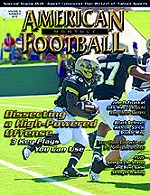Article CategoriesAFM Magazine
|
Goal Line Defense: Lenape Valley’s 6-5 Schemeby: Don SmolynHead Coach Lenape Valley High School (NJ) © More from this issue When introducing our Goal Line Defense to our team, we stress from day one that we must stop the run at all cost – “We are fighting for inches not yards”. As a staff, three principles must be kept in mind at all times: 1. Instill in our players the mindset that “they cannot score by running the football on us – they must pass to score”. Also, attitude is as important as schemes and techniques. 2. Have a limited number of adjustments to formations and motions. 3. Install and be able to execute a limited number of stunts. Base Alignment and Responsibilities Defensive Guards are aligned in a four-point stance with their ins....The full article can only be seen by subscribers.
|
|
|||||||
| HOME |
MAGAZINE |
SUBSCRIBE | ONLINE COLUMNISTS | COACHING VIDEOS |
Copyright 2025, AmericanFootballMonthly.com
All Rights Reserved





